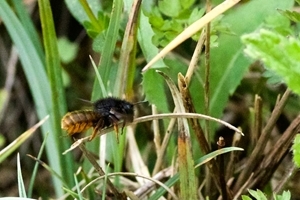Red-tailed mason bee
 In the UK we have over 250 species of bee, which come in many different colours, forms and sizes. Many are specially adapted for certain flowers and habitats, and have unique ways of nesting and breeding. The most familiar to us, of course, are the stereotypical stripy honeybees and bumblebees. However, whilst well-covered in the media and charmingly depicted on every type of product under the sun from lunchboxes to boxer pants, these account for only a very small handful of our national bee assembly, and if the pollination of UK flowers and crops was represented by a cake, they would be a thin slice.
In the UK we have over 250 species of bee, which come in many different colours, forms and sizes. Many are specially adapted for certain flowers and habitats, and have unique ways of nesting and breeding. The most familiar to us, of course, are the stereotypical stripy honeybees and bumblebees. However, whilst well-covered in the media and charmingly depicted on every type of product under the sun from lunchboxes to boxer pants, these account for only a very small handful of our national bee assembly, and if the pollination of UK flowers and crops was represented by a cake, they would be a thin slice.
The majority of our 250 species are what we call solitary bees, and these vitally important insects are split into distinct groups such as mining bees, cuckoo bees, leaf-cutter bees and mason bees.
The latter group, the mason bees, are often observed buzzing in a cloud around brick and stone walls and buildings. Like other solitary bees, once the females are mated, the males die off and the females build nests to lay eggs in. A female may nest in a colony beside others, but always have her own separate nest hole. She will not harness her young as workers – instead they will grow up to be independent females and males to mate and make nests of their own.
Mason bees generally have very furry bodies for carrying pollen and boxy heads, which house a large pair of jaws for chomping up plant and mineral matter to line their nests with. The most commonly observed in gardens is the red mason bee (Osmia bicornis), a uniformly ginger bee, which readily nests in ‘bee hotels’, walls and fence posts.
There’s one type of mason bee that really stands out from its kin: the red-tailed mason bee (Osmia bicolor) which is rare and notable in the UK, occurring only on calcareous grassland over limestone or chalk. What makes this striking black and ginger bi-coloured bee unique is its amazingly niche choice of nesting cavity… snail shells!
The best time to see these bees is when the females nest between April and July. Her first task is to find a suitable empty shell – most commonly the remains of a lemon snail, white-lipped snail or a Roman snail. If the aperture of the vacant snail is obscured, she’ll turn it into a better orientation, a bit like a circus performer atop a walking globe.
Once satisfied, she will get busy making her nest. In each shell there will be room for around 4-5 egg chambers, which she creates and provisions with a ball of chewed up pollen collected from a wide variety of flowers including chalkland vetches, willows, dandelions and daisies. When the eggs are safely blocked into their cells, she will seal the entrance of the snail shell with a sticky plug of leaves and soil to protect from predators.
There is one more step before her nest is finished – she has to disguise the shell by a clever technique called ‘thatching’. This involves foraging for flower stalks, twigs and blades of grass and carrying them back to lay over the shell. Sometimes the pieces are so long that it looks as if she is riding a broomstick! A female can find, carry and lay as many as 30 substantial pieces of plant material in half an hour – quite a remarkable feat when you consider what the equivalent human activity might be!
Her breeding season is complete when she has repeated this process for up to six or seven snail shells, and she dies shortly afterward. The following year, in very early spring, the new males hatch out of the shells and lie in wait for the fertile females, and the life cycle begins afresh.
If you’re lucky enough to spot a female going about these remarkable tasks, give a nod to this clever and resourceful little mason bee – the trend-setters in upcycling!
Jess Brooks
Advisory
Photo credit: c.a.h.w.